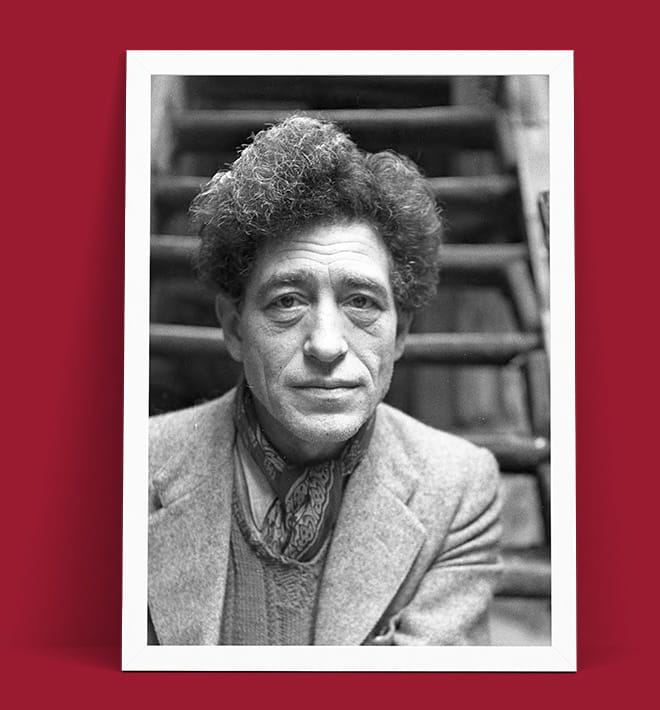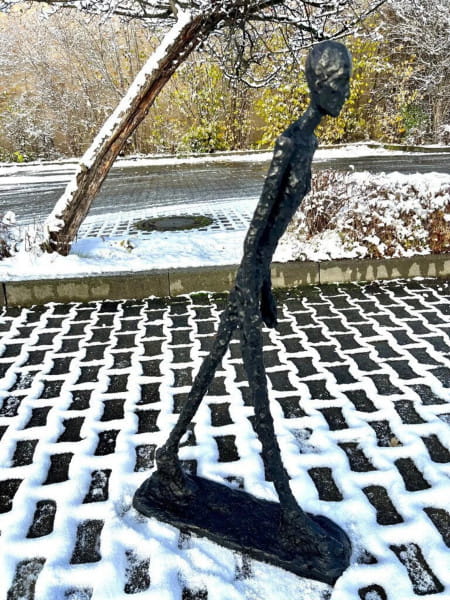Prices incl. VAT, free shipping worldwide
Ready to ship today,
Delivery time appr. 3-6 workdays










Product description
"Walking Man I - L'Homme qui marche I - Alberto Giacometti Sculptures - 120cm"
| Height | 120 cm |
| Width | 20 cm |
| Length | 62 cm |
| Weight | 20 kg |
A Step Through Silence - Walking Man I – L’Homme qui marche I (120 cm) - Signed Giacometti
The sculpture depicts a man mid-step, his body extended forward, one foot lifted in motion, the other grounded in stillness. The arms hang at his sides, elongated and attenuated, the head gazes slightly downward. Every line in the body suggests movement, and yet the entire figure feels as if frozen in time. This paradox—of motion arrested, of presence evaporating—is central to the emotional impact of the work. In this form, Alberto Giacometti Artwork achieves its most distilled philosophical expression: to exist is to be between places, between moments, between being and vanishing.
A Life Defined by Form and Distance
Alberto Giacometti was born on October 10, 1901, in the quiet Swiss village of Borgonovo, in the rugged alpine region of Val Bregaglia. From this landscape of isolation and sublime vastness emerged one of the most introspective and revolutionary sculptors of the twentieth century. As the eldest son of the post-impressionist painter Giovanni Giacometti, Alberto was immersed early in a world of visual experimentation and artistic discipline. Though his early years were shaped by painting and drawing, it was in sculpture that he ultimately found a language capable of expressing the elusive truth of human presence. Over decades of tireless searching, he built a legacy that is today recognized as Giacometti Art, a body of work that redefined the boundaries between material, void, and vision.
The Postwar Years and the Reinvention of the Human Figure
Walking Man I (L’Homme qui marche I) was created in 1960 in Paris, during the final decade of Giacometti’s life, and stands among the most iconic and influential works in all of modern sculpture. Emerging from a long period of philosophical and artistic introspection following World War II, Giacometti began to strip the human figure of all embellishment, reducing it to its essential gesture: to stand, to move, to endure. This sculpture is not a portrait, not a narrative—it is a distilled presence, a figure carved out of space and time. At 120 cm tall, this version captures the full expressive power of the original model while remaining intimately human in scale. Among the great Giacometti Sculptures, Walking Man I occupies a singular place as a monument not to triumph, but to persistence.
Bronze That Carries Weight and Wind
Cast in raw, uneven bronze, the surface of Walking Man I vibrates with energy and tension. It does not shimmer with polish but hums with honesty. Every ridge and crevice bears the imprint of the artist’s fingers, each mark left uncorrected, each imperfection part of the sculpture’s truth. This refusal to beautify or idealize is essential to Giacometti Sculptures, where material becomes memory and matter becomes meaning. The bronze does not depict a man walking through the world—it becomes the world through which he walks.
Walking as Existential Gesture
What makes Walking Man I so hauntingly powerful is the utter simplicity of its concept: a single man, walking. But this walk is not heroic or symbolic—it is human. It is the daily movement through time, the slow continuation despite uncertainty. In Giacometti’s hands, walking becomes a metaphysical act, an affirmation of being even in the face of erasure. His postwar sculptures reflect the philosophy of Sartre and Camus, where meaning must be created in the act of living itself. In this way, Walking Man I is not simply sculpture—it is lived thought, it is silent resilience rendered in bronze. It is one of the clearest voices in the chorus of Giacometti Art.
A Vertical Presence in the Horizontal World
Unlike classical sculpture, which often anchors the human form to a pedestal of grandeur, Giacometti’s figure rises thin and bare from the ground, a vertical mark etched into emptiness. The figure stands exposed, vulnerable, and unsheltered—an image not of dominance, but of existence. Even at 120 cm, this version of Walking Man I retains the solemn grandeur of its monumental relatives. It stands not over the viewer, but with him. It does not dominate space—it defines it. It is the measure of our own body in space, and of the distance between presence and absence.
A Global Icon of Modern Sculpture
Walking Man I has come to represent far more than the artist’s personal vision. It has become a universal symbol—of endurance, of humanity, of the fragile beauty of continuing. One version of the work famously sold for over $100 million at auction, but its true value lies not in the market, but in its meaning. It is a sculpture that belongs to everyone, because it speaks to what we all are: solitary, moving, enduring. It is the very heartbeat of Giacometti Art.
The Step That Never Ends
Walking Man I – L’Homme qui marche I by Alberto Giacometti is more than a sculpture—it is a presence, a question, a breath between two moments. It carries within its fragile limbs the entire burden and wonder of human life. It does not explain, it does not conclude—it simply walks. And in that walk, we find ourselves. Among all Giacometti Sculptures, this work stands as the most distilled expression of his genius. It is not the man who walks, but the walk itself that speaks—the eternal movement through space, time, and thought, captured in bronze and forever in motion.
The weight is 20 kg bronze
Our advantages
free shipping
Worldwide free shipping
14 days money back
You can cancel your order
within 14 days
secure payment services
Paypal, Master Card, Visa, American Express and more








































